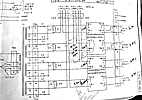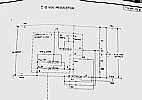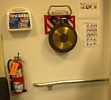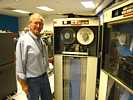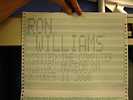Schedule October 2008
return to main 1401 Restoration Page
go to Team Bios
Contents:
Wed October 01 - general
I machined the worn shaft and sleeved it with a 0.016 thick wall sleeve and locktite'd it on. The sleeve was made to be a snug fit to the new bearing but they should be attached with a small drop of light hold loctite to prevent them spinning and wearing the shaft again.
I made a new rubber tire. The old one measured about 1.1" diameter and was fairly soft so I picked a similar 0.375" stock I happened to have. Machining this rubber is about impossible so I punched the id undersize and stretched the tire onto the brass slider.
What I don't know is what the "new" od should be? Right now it is 1.27" To make it smaller I have to grind or sand off material. This is a very messy process so I want to do it only once.
After the final od is obtained, I will glue the new tire to the brass slider. The original tire was molded on and it appears from the design there was more concern about it being run off the brass sideways than rotary slipping.
Or I can drop it off tomorrow "as is" and Frank can do the rest. Let me know.
Grant
Reply to above by Frank King
It sounds perfect.
Thanks again for the fix.
Attendees: New: Jim Hartley, Ron Williams, Bob Erickson, Frank King, Allen Palmer, Judith Haemmerle, Glen Lea, Joe Preston, Robert Garner
* DE 1401
Thursday October 02 - Tape Team
Wednesday October 08 - General
Bob Erickson mentioned that Joe Preston ruined our today's record of non-accompishment. Apparently he got one of the CT tape
units responding to the CT TAU (Tape Unit Adaptor) control panel.
Thursday October 09 - Tape Team
Saturday October 11 - 2nd Saturday
Wednesday October 15 - General
Thursday October 16 - Tape Team
Wednesday October 22 - General
Thursday October 23 - Tape Team
Saturday October 25 - 4th Saturday
Wednesday October 29 - General
Thursday October 30 - Tape Team
Wed Oct 1 - General, Thurs Oct 2 - tape team
Wed Oct 8 - General, Thurs Oct 09 - tape team, Sat Oct 11 - 2nd Sat
Wed Oct 15 - General, Thurs Oct 16 - tape team
Wed Oct 22 - General, Thurs Oct 23 - tape team, Sat Oct 25 - 4th Sat
Wed Oct 29 - General, Thurs Oct 30 - tape team
E-mail from Grant Saviers - relative to pictures here.
The basic repairs are complete. I bought new bearings for both ends and will leave the gear removal and that end bearing replacement to Frank.
Thanks Grant.
I will take your advice about the Locktite.
As I was checking the plate the rubber runs on. I found that the spring that loads the plate against the rubber
has greater than 1/4 inch movement.
This would leave the diameter of the rubber wheel a tolerance of greater than that.
Frank
* CT 1401
Thursday, Oct. 2, 2008 - (Ron W., Jeff S., Sam S. and I)
There were reports of tape troubles with the German 1401, so we worked
on it today.
We believe that there is something seriously broken in the 729. If
Allen doesn't find the problem next Wednesday, we will start
investigating inside the 729 next Thursday.
Regards,
Bob Feretich
- hope they forgot who they lent it to -
and verified that the power supply was still sick - bumber - it still was :-((
By that time, Robert Garner was trying to test the old transistor with his transistor tester - he was saying something like
"Maybe we will have to read the book." I left for Radio Shack in a hurry, not wanting to be involved with
reading instructions !!
Like How low can you go??
Suggestions accepted - should I offer a reward?
The 3,2v going into the +12v power supply is the reading with the cb closed. what that means is that the problem is not .. good input voltage and bad output. what it does mean is that the voltage going into the +12v regulator is being pulled down to 3.2 volts. The output is the same as the input ... 3.2v This should help in the determination of the problem.
allen
My plan for next session is to parallel that "good" transistor with a hopefully good spare :-||
Unless you have a better idea?
TAU debug status - Thursday, 10-9-08 (Jeff S., Sam S., and I)
Allen reported that the 729 on the German system was working, so we
moved the Emulator back to the Connecticut system.
Regards,
Bob Feretich
After reading my sorry tale of trouble shooting above, John Van Gardner offered
this unsympathetic cartoon. :-((
"While reading about your bout with the 729 power supply last Wednesday,
I could not help but think about something I kept over my desk before I retired."

Fun-n-games. A visitor had heard that an IBM card with all the punch positions punched out settled flatly while
falling, in contrast to the side-to-side oscillations of an unpunched IBM card. Why not try it - be our own
"Myth Busters" ;-)) So the guest punched almost all the 80 x 12 = 960 holes (It is hard to be purfekt.)

The proof is in the pudding - and indeed, a laced card settles with very little side to side dynamics.
Now, who would have asked? Who would have guessed? Somebody had too much time?

TAU Debug Status - Thursday, Oct 23rd (Jeff S., Sam S., Ron W., &
me)
The failure would occur on he second record read by step 5 above. The
TAU would begin to read the second record only .8 to 1.2 milliseconds
after it dropped "GO" for the first record. The TAU must at least allow
2 milliseconds between operations for the tape to stop. The problem is
sensitive to the setting of the "Go Down" pot position. The circuit for
"Go Down" uses two single shots that tie into a rats nest of feedback
logic. Replacing or retuning the single shots didn't help.
Hopefully the problem will be back again next week so we can shoot it.
Also:
Regards,
Bob Feretich
TAU Debug Status - Oct. 30, 2008 (Jeff S., Sam S., Grant
S. and me)
We continued debug on the CE Panel Read Continuous problem that I
reported last week. We are fairly certain that the problem is in the
retriggerable "single shot" that is supposed pace continuous CE panel
operations (NB@02A1D11 71.71.61 block 4A). We have replaced the card,
trying the two spares and the card from the German 1401. The
replacements do not fix the problem. Normally this would tell us that
the card is good, and the problem is elsewhere in the circuit, but we
cant see how any of the other logic in the area could be causing the
symptoms we are seeing.
Logic analysis:
There are a lot of signals involved, but I believe the important
sequence is...
When we examine a stream of pulses created by the single-shot, pulses 3
through N are uniform and many milliseconds wide. Pulse 2 is about 90%
of the width of pulse 3. Pulse 1 is very narrow (often less than one
millisecond wide). By probing pin E of the single-shot, we see that the
down level viewed on this pin starts at about -12V and rises to about
-8V. It stabilizes at -8V during the second pulse. We believe that the
shift in this "down level" is causing the variation in pulse widths.
We know that pulse widths less than about 1.5 milliseconds violate the
tape "stop" timing. (The previous tape read or write operation is still
in progress for about 1.5 milliseconds after the TAU drops busy. This
is the overlappable period at the end of tape operations.) For the
circuit to work properly the minimum pulse generated from the
single-shot must be greater than 1.5 ms. The note at the bottom of the
ALD page states that the single-shot should be adjusted so that the
minimum pulse is 10 ms (with the GO DOWN pot set at its fastest
position). We are unable to adjust the single-shot so that its minimum
pulse width is >1.5ms.
We need somebody who knows more than us about circuits to look at this
single-shot circuit and tell us why it can't be set to produce a
consistent pulse width that is >1.5 ms.
Ron, can you examine it?
Regards,
Bob Feretich
Go to November 2008
go to Team Bios
